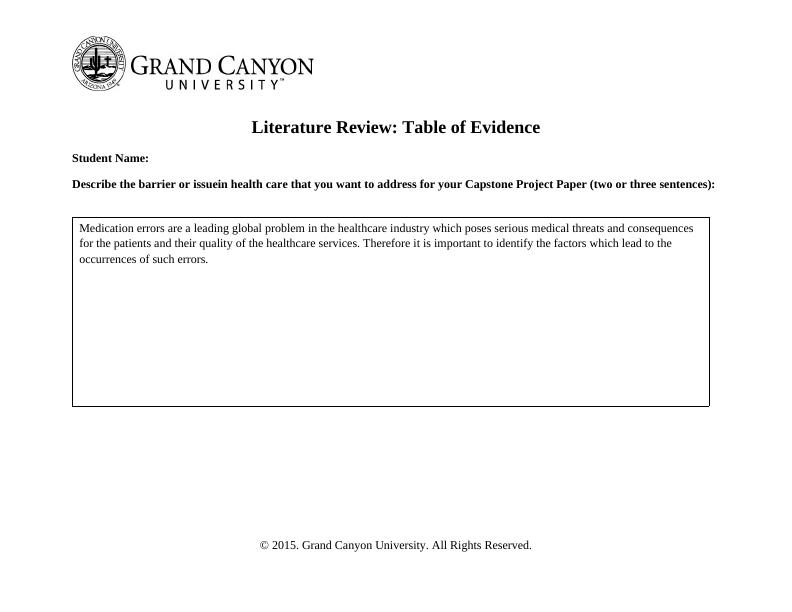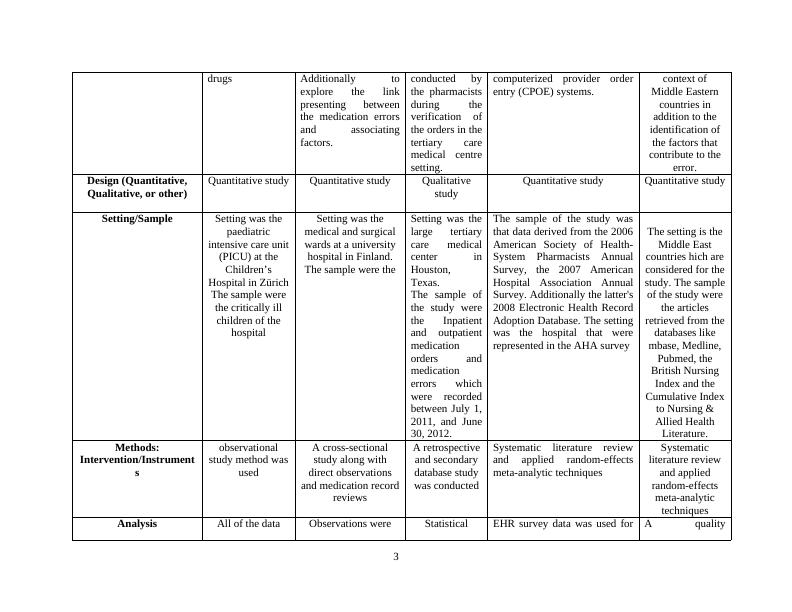Literature Review: Table of Evidence
Added on 2023-04-20
6 Pages1622 Words360 Views
Literature Review: Table of Evidence
Student Name:
Describe the barrier or issuein health care that you want to address for your Capstone Project Paper (two or three sentences):
© 2015. Grand Canyon University. All Rights Reserved.
Medication errors are a leading global problem in the healthcare industry which poses serious medical threats and consequences
for the patients and their quality of the healthcare services. Therefore it is important to identify the factors which lead to the
occurrences of such errors.
Student Name:
Describe the barrier or issuein health care that you want to address for your Capstone Project Paper (two or three sentences):
© 2015. Grand Canyon University. All Rights Reserved.
Medication errors are a leading global problem in the healthcare industry which poses serious medical threats and consequences
for the patients and their quality of the healthcare services. Therefore it is important to identify the factors which lead to the
occurrences of such errors.

Criteria Article 1 Article 2 Article 3 Article 4 Article 5
Author, Journal (Peer-
Reviewed), and
Permalink or Working
Link to Access Article
Corina
Glanzmann,
Bernhard Frey,
Christoph R.
Meier and
PriskaVonbach
Eur J Pediatr(Peer
reviewed)
DOI
10.1007/s00431-
015-2542-4
Marja Hark € anen,
JouniAhonen,
MarjoKervinen,
HanneleTurunen and
KatriVehvilainen-
Julkunen
Scandinavian journal
of caring sciences
(Peer reviewed
journal)
doi:10.1111/
scs.12163
Christy
Gorbach, Linda
Blanton,
Beverly A.
Lukawski, Alex
C. Varkey, E.
Paige Pitman,
and Kevin W.
Garey.
American
Journal of
Health-System
Pharmacy (peer
reviewed)
David C Radley Melanie R
Wasserman Lauren EW
Olsho Sarah J ShoemakerMark
D Spranca Bethany Bradshaw
Jamia- A scholarly journal of
informatics in health and
medicine.
https://doi.org/10.1136/
amiajnl-2012-001241
Zayed Alsulami,
Sharon Conroy
and
Imti Choonara
European Journal
of Clinical
Pharmacology.
ArticleTitle and Year
Published
Analysis of
medication
prescribing errors
in critically ill
children (2015)
The factors associated
with medication
errors in adult medical
and surgical
inpatients: a direct
observation approach
with medication
record reviews (2015)
in a tertiary
care medical
center, during
verification of
order , risk
factors of
medication
errors as well as
Frequency by
pharmacists
(2015)
Minimization of medication
errors in hospitals because of
adoption of computerized
provider order entry
systems (2013)
Medication errors
in the Middle East
countries: A
systematic review
of the literature
(2012)
Research Questions
(Qualitative)/Hypothesis
(Quantitative), and
Purposes/Aim of Study
Assessment of the
MPEs in children
who are critically
ill, helps to reduce
the occurrence of
serious medical
errors in the use
of the prescribed
This study aimed to
determine
the ,frequency ,types
and severity of
medication errors
which is present in
medical and surgical
inpatients.
The purpose of
the study is to
determine the
frequency of
the risk factors
related to the
medication
errors
The objective of this study is to
derive the national
representative of the estimation
of the errors of medication
related to the reduction in the
errors in hospitals which are
attributable to electronic
prescribing through
The objective of
this study is to
conduct a
systematic review
of the incidences
and the types of
the medication
errors in the
2
Author, Journal (Peer-
Reviewed), and
Permalink or Working
Link to Access Article
Corina
Glanzmann,
Bernhard Frey,
Christoph R.
Meier and
PriskaVonbach
Eur J Pediatr(Peer
reviewed)
DOI
10.1007/s00431-
015-2542-4
Marja Hark € anen,
JouniAhonen,
MarjoKervinen,
HanneleTurunen and
KatriVehvilainen-
Julkunen
Scandinavian journal
of caring sciences
(Peer reviewed
journal)
doi:10.1111/
scs.12163
Christy
Gorbach, Linda
Blanton,
Beverly A.
Lukawski, Alex
C. Varkey, E.
Paige Pitman,
and Kevin W.
Garey.
American
Journal of
Health-System
Pharmacy (peer
reviewed)
David C Radley Melanie R
Wasserman Lauren EW
Olsho Sarah J ShoemakerMark
D Spranca Bethany Bradshaw
Jamia- A scholarly journal of
informatics in health and
medicine.
https://doi.org/10.1136/
amiajnl-2012-001241
Zayed Alsulami,
Sharon Conroy
and
Imti Choonara
European Journal
of Clinical
Pharmacology.
ArticleTitle and Year
Published
Analysis of
medication
prescribing errors
in critically ill
children (2015)
The factors associated
with medication
errors in adult medical
and surgical
inpatients: a direct
observation approach
with medication
record reviews (2015)
in a tertiary
care medical
center, during
verification of
order , risk
factors of
medication
errors as well as
Frequency by
pharmacists
(2015)
Minimization of medication
errors in hospitals because of
adoption of computerized
provider order entry
systems (2013)
Medication errors
in the Middle East
countries: A
systematic review
of the literature
(2012)
Research Questions
(Qualitative)/Hypothesis
(Quantitative), and
Purposes/Aim of Study
Assessment of the
MPEs in children
who are critically
ill, helps to reduce
the occurrence of
serious medical
errors in the use
of the prescribed
This study aimed to
determine
the ,frequency ,types
and severity of
medication errors
which is present in
medical and surgical
inpatients.
The purpose of
the study is to
determine the
frequency of
the risk factors
related to the
medication
errors
The objective of this study is to
derive the national
representative of the estimation
of the errors of medication
related to the reduction in the
errors in hospitals which are
attributable to electronic
prescribing through
The objective of
this study is to
conduct a
systematic review
of the incidences
and the types of
the medication
errors in the
2

drugs Additionally to
explore the link
presenting between
the medication errors
and associating
factors.
conducted by
the pharmacists
during the
verification of
the orders in the
tertiary care
medical centre
setting.
computerized provider order
entry (CPOE) systems.
context of
Middle Eastern
countries in
addition to the
identification of
the factors that
contribute to the
error.
Design (Quantitative,
Qualitative, or other)
Quantitative study Quantitative study Qualitative
study
Quantitative study Quantitative study
Setting/Sample Setting was the
paediatric
intensive care unit
(PICU) at the
Children’s
Hospital in Zürich
The sample were
the critically ill
children of the
hospital
Setting was the
medical and surgical
wards at a university
hospital in Finland.
The sample were the
Setting was the
large tertiary
care medical
center in
Houston,
Texas.
The sample of
the study were
the Inpatient
and outpatient
medication
orders and
medication
errors which
were recorded
between July 1,
2011, and June
30, 2012.
The sample of the study was
that data derived from the 2006
American Society of Health-
System Pharmacists Annual
Survey, the 2007 American
Hospital Association Annual
Survey. Additionally the latter's
2008 Electronic Health Record
Adoption Database. The setting
was the hospital that were
represented in the AHA survey
The setting is the
Middle East
countries hich are
considered for the
study. The sample
of the study were
the articles
retrieved from the
databases like
mbase, Medline,
Pubmed, the
British Nursing
Index and the
Cumulative Index
to Nursing &
Allied Health
Literature.
Methods:
Intervention/Instrument
s
observational
study method was
used
A cross-sectional
study along with
direct observations
and medication record
reviews
A retrospective
and secondary
database study
was conducted
Systematic literature review
and applied random-effects
meta-analytic techniques
Systematic
literature review
and applied
random-effects
meta-analytic
techniques
Analysis All of the data Observations were Statistical EHR survey data was used for A quality
3
explore the link
presenting between
the medication errors
and associating
factors.
conducted by
the pharmacists
during the
verification of
the orders in the
tertiary care
medical centre
setting.
computerized provider order
entry (CPOE) systems.
context of
Middle Eastern
countries in
addition to the
identification of
the factors that
contribute to the
error.
Design (Quantitative,
Qualitative, or other)
Quantitative study Quantitative study Qualitative
study
Quantitative study Quantitative study
Setting/Sample Setting was the
paediatric
intensive care unit
(PICU) at the
Children’s
Hospital in Zürich
The sample were
the critically ill
children of the
hospital
Setting was the
medical and surgical
wards at a university
hospital in Finland.
The sample were the
Setting was the
large tertiary
care medical
center in
Houston,
Texas.
The sample of
the study were
the Inpatient
and outpatient
medication
orders and
medication
errors which
were recorded
between July 1,
2011, and June
30, 2012.
The sample of the study was
that data derived from the 2006
American Society of Health-
System Pharmacists Annual
Survey, the 2007 American
Hospital Association Annual
Survey. Additionally the latter's
2008 Electronic Health Record
Adoption Database. The setting
was the hospital that were
represented in the AHA survey
The setting is the
Middle East
countries hich are
considered for the
study. The sample
of the study were
the articles
retrieved from the
databases like
mbase, Medline,
Pubmed, the
British Nursing
Index and the
Cumulative Index
to Nursing &
Allied Health
Literature.
Methods:
Intervention/Instrument
s
observational
study method was
used
A cross-sectional
study along with
direct observations
and medication record
reviews
A retrospective
and secondary
database study
was conducted
Systematic literature review
and applied random-effects
meta-analytic techniques
Systematic
literature review
and applied
random-effects
meta-analytic
techniques
Analysis All of the data Observations were Statistical EHR survey data was used for A quality
3

End of preview
Want to access all the pages? Upload your documents or become a member.
Related Documents
Research in Nursing: Quantitative and Qualitative Studieslg...
|6
|1095
|129
Literature Evaluation Tablelg...
|6
|2476
|198
The Impact of Interruptions on Medication Errors in Hospitalslg...
|10
|2521
|54
The Effectiveness of a Pressure Ulcer Intervention Programlg...
|6
|1997
|12
Search Strategy for Patient Communication in Healthcarelg...
|11
|1052
|53
Adverse Drug Reactions in Hospital Inpatients: A Prospective Observational Studylg...
|4
|573
|110
